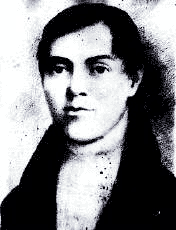The Métis
Riel House National Historic Site
- Beginnings
- The Métis nation
- The buffalo hunt
- Cuthbert Grant (1793-1854)
- Marie-Anne Gaboury (1780-1875)
- Language
The term Métis has its origins in the Latin word 'mixticius' which means a person of mixed racial ancestry. Métis, however, describes more than race: it refers to a culture and a nation that played a significant role in the history of the Canadian West and is now a proud part of the Canadian mosaic.
Beginnings
The Métis have their origins in the fur trade. The first European traders, mostly from New France travelled into the interior of North America to trade for furs, which they then shipped back to Europe. The French Canadians had to rely on Indigenous peoples, principally women, to find food, fix canoes, make clothes, navigate rivers and in general survive in the unfamiliar terrain of the Northwest. As the famous explorer Alexander Mackenzie lamented, "I have not a single one in my fort that can make Rackets [snowshoes]. I do not know what to do without these articles. See what it is to have no wives. Try and get Rackets-there is no stirring without them." It is no exaggeration to say that without the help and support of Indigenous women, the fur trade would not have been possible in the Northwest.
For their part, Indigenous women's participation in the fur trade was practical. Today we can only imagine the discomfort of living through a winter in Western Canada without metal pots and kettles for cooking and heating water. Life was made easier by European trade goods. There were important economic and diplomatic reasons for fur traders and Indigenous women to marry, but contrary to popular myth, these marriages were not all marriages of convenience, or marriages that only lasted a season or two. Rather, they ran the whole range, as marriages do today, from devoted pairings of two people to more perfunctory arrangements.
The offspring of these marriages were neither European nor Indigenous, but formed distinct communities with unique cultural traits. From their mothers they learned the skills they needed to survive and from their fathers they inherited the outlook of earning their livelihoods in the fur trade. Typically, the first generations of Métis worked as independent traders and guides for the French or the NorthWest Company. Their contributions varied: some worked as voyageurs, paddling the canoes that carried the trade goods inland and the furs to a port, while others were hunters, and still others served as interpreters. They established a settlement at the junction of the Red and Assiniboine rivers (now the centre of Winnipeg) for the same reasons that the area had drawn Indigenous peoples for thousands of years-both rivers were highways to rich hunting and trapping territories. The Métis at Red River could travel south in the summer, hunt buffalo, bring it back preserved as pemmican, net fish in the rivers, plant some crops and sell their surplus to the fur trading companies who could easily ship the provisions to the Northwest.
From 1780 to 1820, two fur trading companies, the NorthWest Company (NWC) and the Hudson's Bay Company (HBC), competed hotly and sometimes violently. Because the NWC was the first to establish itself inland, they were the principal customers and employers of the Red River Métis. One of the leading shareholders of the HBC, Lord Selkirk, brought settlers from Scotland and established them beside the growing Métis settlement at Red River. The Selkirk settlers were intended to fill the same role as the Métis-to support the fur trade with provisions and serve as a ready labour force if needed. After the settlers arrived in 1811-15, the HBC provoked theMétis by prohibiting the export of pemmican from Red River. Outraged at the attempt to deny them their livelihood, the Métis confronted the HBC and its allies in an armed conflict with settlers at Seven Oaks (also known as La Grenouillière). The result was two dead Métis, 20 dead settlers and the HBC taking care not to confront the Métis again. While the details surrounding this event remain the subject of some debate, its importance lies in the emergence of the Métis sense of nation as "Bois-Brûlés."
The Métis nation
The time from 1820 to 1870 has been described as the "golden age" of the Métis nation. Although they remained key participants in the fur trade, they also pursued a mixed economy which included farming and free trading. The Métis developed their own laws and developed a sense of identity and a culture unique to the Canadian West.
The buffalo hunt

© Provincial Archives of Manitoba
The Métis were increasingly relied upon to supply the fur trade with pemmican even after the rival fur companies united in 1821. Buffalo had become scarce in the area around Red River by this time and the hunters had to go southwest for a considerable distance to find sizeable herds, which meant trespassing on the hunting grounds of the Dakota. For security, the Métis hunters began travelling and hunting in groups, which gave rise to a memorable spectacle. The hunt of 1840 included 620 men, 650 women, 360 children, 586 oxen, 655 cart horses, and 403 'buffalo runners' (fast horses). In other words, more than one-third of the Red River Settlement packed up their belongings and set off on a dangerous expedition that would last for months. The carts and most of the people and beasts would return laden with pemmican and buffalo hides. Both of these were sold to the HBC and to American traders on a scale that would support the community for a year. Their hunts brought them into conflict with the Dakota but the military organization and discipline of the Métis helped them overcome their rivals.
Although the Dakota have been historically identified as the Sioux, the people refer to themselves as Dakota. 'Sioux' was the name given to them by their enemies the Iroquois, and, not surprisingly, is a derogatory term meaning snake or serpent in Iroquoian. Interestingly, Iroquois means snake or serpent in Algonquian. The names by which Euro-Canadians identify First Nations people follow the pattern of European contact and betrays the political conflicts and allegiances that predate European arrival.

Cuthbert Grant (1793-1854)
One of the greatest of the early Métis leaders was Cuthbert Grant. The son of a Scottish NWC trader and a Métis woman, he was educated in Montréal (and perhaps Scotland) and took up employment with the NWC as a young man. It was Grant who led the Métis at Seven Oaks. With the reputation of being a loyal friend and dangerous enemy, Grant was courted by the HBC, who paid him a good salary, named him 'Warden of the Plains' and gave him a large tract of land west of the Red River Settlement at White Horse Plains. For the next thirty years, Grant led the skirmishes with the Dakota during the buffalo hunts, served as a magistrate and on the Council of Assiniboia, the local government of the Settlement. He died in 1854 from injuries he suffered after being thrown from a horse.
Marie-Anne Gaboury (1780-1875)
She has been described as the grandmother of the Métis of Red River. In defiance of established tradition, Marie-Anne insisted on accompanying her new husband, the voyageur Jean-Baptiste Lagimodière, to the Northwest in 1806 and became the first French Canadian woman to settle in the region. After an arduous journey by canoe, she reached the Métis community of Pembina (present-day North Dakota) where she gave birth to a daughter called Reine in 1807. Marie-Anne travelled with her husband to Fort des Prairies (present-day Edmonton area) and the Cypress Hills before establishing a permanent residence at the confluence of the Red and Seine rivers (present-day Winnipeg) around 1816. A tolerant and generous woman, she accepted her husband's children from previous country marriages and gained the respect of Indigenous women. She taught them Christian values and they taught her Cree and Ojibway and how to live off the land. Mrs. Lagimodière lived a long fruitful life, and witnessed the achievements of her grandson, Louis Riel, as a founder of Manitoba.
Language

While many Métis spoke French, English and a number of Indigenous languages, they spoke Michif among themselves. Modern linguists don't agree whether Michif is a Cree dialect, a Creole language, 'pidgin' French or a 'mix' of Cree and French. What they do agree on, though, is that it contains words and grammatical characteristics of both Cree and French, and Michif's similarities to the other two languages is evident.
English: What is your name? - My name is John Baptiste.
Michif: Kaykwy tou nou? - Mou nou si Jean Bachis.
French: Quel est ton nom? - Mon nom est Jean-Baptiste.
Cree: Tawnshi eshinihkawahouyen? - Jean Bachis zhinihkawshoun.
- Date modified :